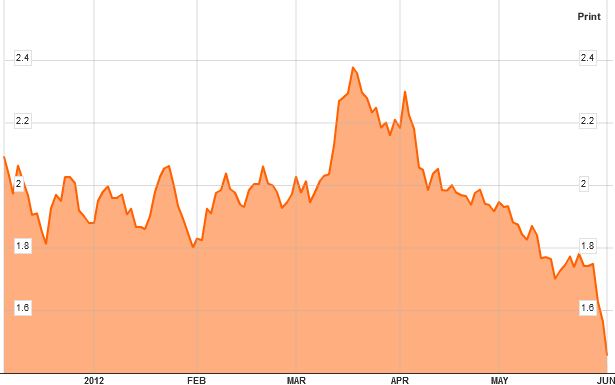How to understand the ongoing plunge in bond yields, as investors rush into the safety of U.S. Treasuries and German debt (where they’re paying the government to hold their money for 2 years!)? Here’s Eddy Elfenbein, from his highly recommended weekly roundup email:
On Thursday, the yield on the 10-year Treasury bond got as low as 1.54% which is the lowest yield in the history of the United States. The previous low came in November 1945, and that’s when the government worked to keep interest rates artificially low. A little over one year ago, the 10-year yield was over 3.5%. Some analysts are now saying the yield could soon fall under 1%.
Don’t blame the Federal Reserve for the current plunge in yields. While the Fed is currently engaged in its Operation Twist where it sells short-term notes and buys long-term bonds, that program is far too small to have such a large impact on Treasury rates. The current Treasury rally is due to concerns about our economy and the desire from investors in Europe to find a safe haven for their cash. I strongly urge investors to stay away from U.S. Treasuries. There’s simply no reward for you there. Consider that the real return is negative for TIPs that come due 15 years from now. Meanwhile, the S&P 500 is going for 11 times next year’s earnings estimate. That translates to an earnings yield of 9%.
But then there’s Robert Kessler, profiled in Randall Forsyth’s column in this week’s Barron’s. Kessler was bullish on Treasuries while almost nobody was over the past year, and isn’t changing his tune. Unlike Elfenbein, Kessler says the pressure on yields is all about the Fed, and he’s one of those whom Elfenbein notes expects Treasury yields to fall even further:
Simply put, Kessler says Treasury yields are the product of the Federal Reserve’s policy stance — which has been to peg the overnight federal-funds rate at virtually zero — and inflation, which is nowhere in sight with the retreat in Commodity Research Bureau index and key prices such as copper.
Based on historical norms, the 10-year Treasury note would trade at 75-100 basis points (0.75 to one percentage point) above the fed-funds rate target. So a 1.20% 10-year T-note would be in line with past cycles. So, too, would a 30-year bond yielding 1.50%-1.60%, well below 2.66% currently.
But these times are different from history with deleveraging throughout the world economy. That means shrinking balance sheets as assets are shed and, Kessler contends, inevitable deflation. If anything, that would point to even lower yields… Kessler says he will get interested in stocks when the VIX — the index measuring volatility of options on the Standard & Poor’s 500 — soars to panic levels of 50-80, from the mid-20s level currently. By then, the S&P 500’s yield is apt to be closer to 6%, a level consistent historically with market bottoms.





